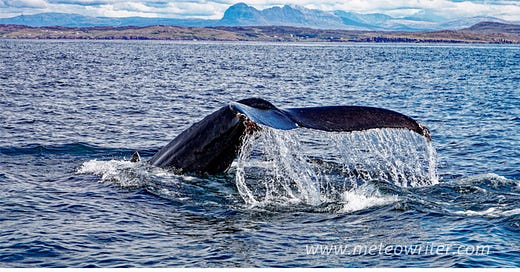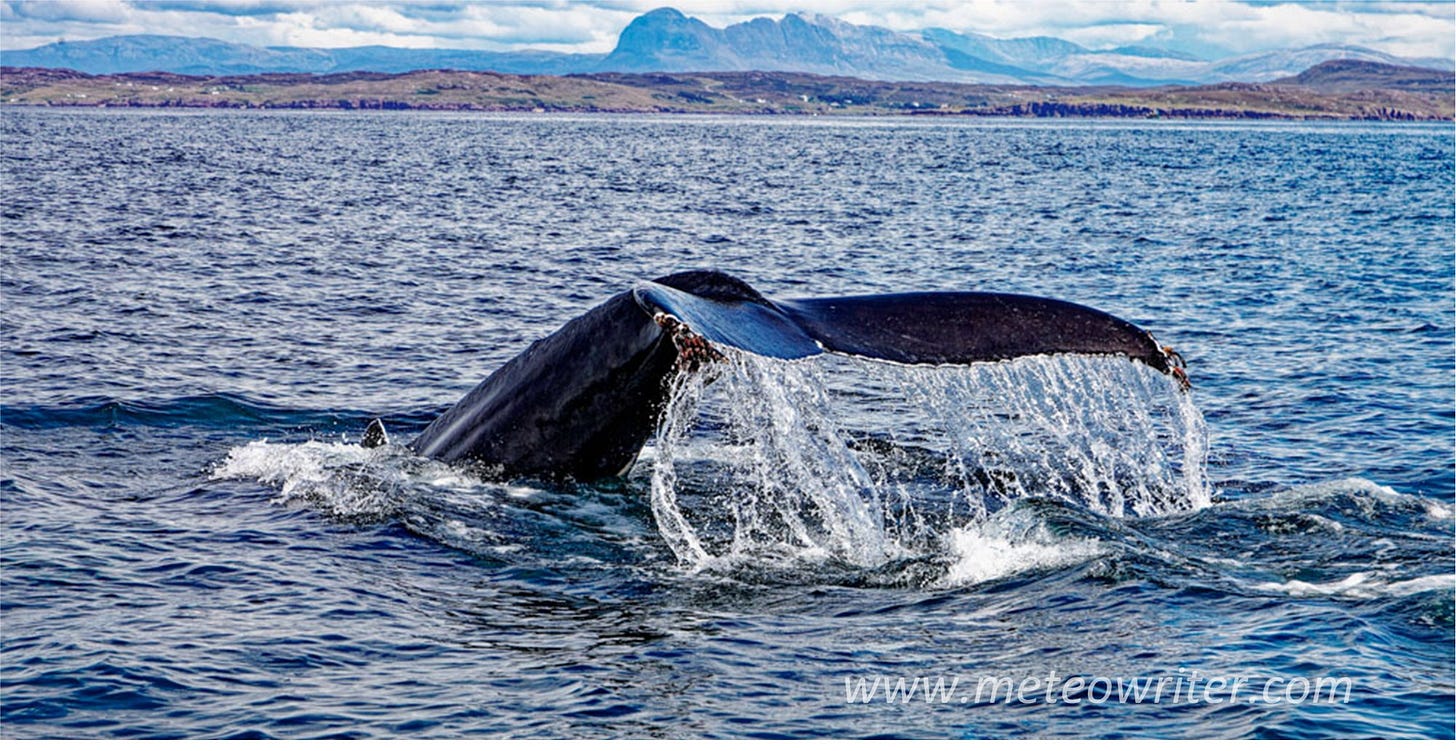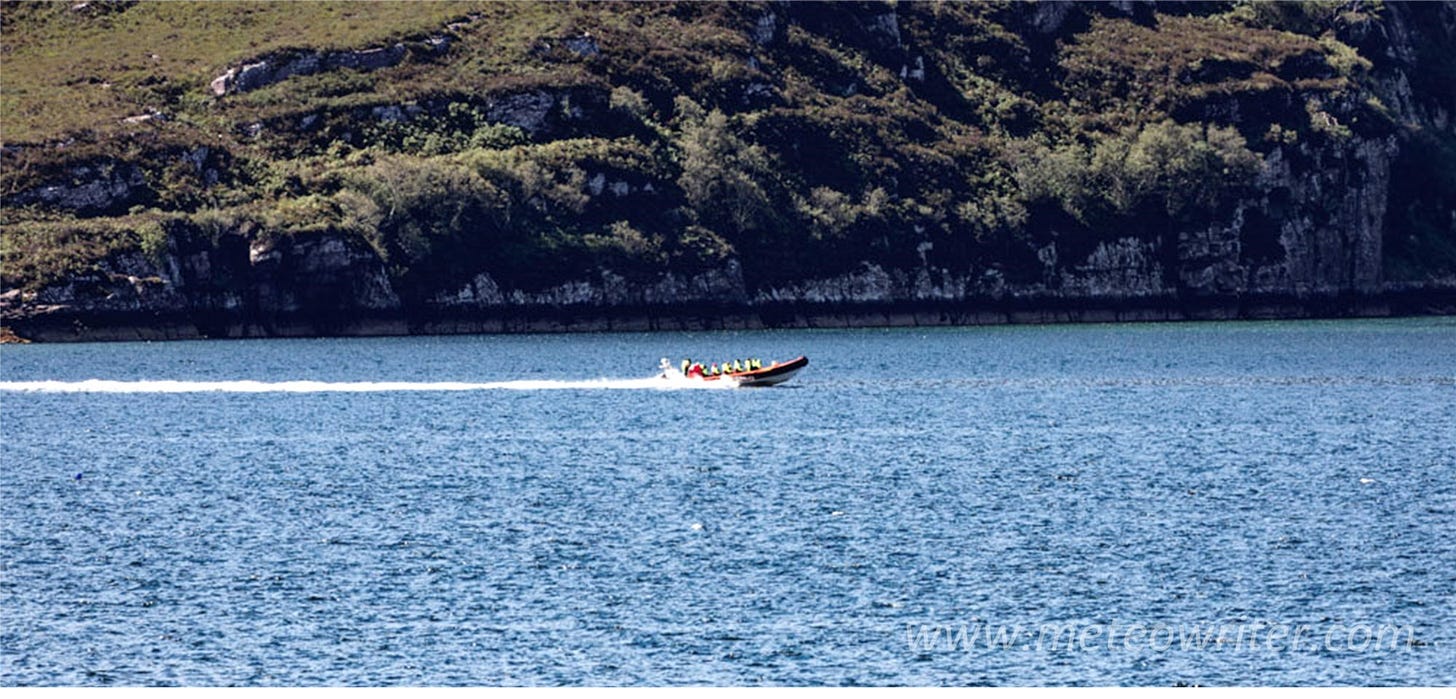Many years ago, I was lucky enough to camp on the shores of a shallow bay that was a pit stop for grey whales on their annual migration between the Arctic and Mexico. Ever curious, some would even have a quick look around at what was happening above the surface by lifting themselves up vertically, in a manoeuvre known as spyhopping.
This was on a cycling trip to Central America and led to the thought that whale watching was something exotic, only to be done in foreign climes or on expensive cruises. However, much more recently, I joined one of the Sea Watch Foundation’s public whale and dolphin watching days in Cumbria where one of their experts said that the northwest of Scotland was also worth considering.
A grey whale spyhopping on the Pacific shores of Baja California, near the camping spot
The idea was planted and the week before last - after several days of avidly watching weather forecasts and reports of sightings - saw us kitted out with buoyancy aids and blue and yellow flotation suits at Ullapool, ready for a three hour RHIB trip out to sea. Rigid Hull Inflatable Boats, in case you don’t know, are very capable high speed craft, increasingly used by wildlife tour companies as well as in the offshore industries and for maritime rescue.
After briefly watching dolphins and seals in Loch Broom, we headed out to sea to the large expanse of water called The Minch. At more than 70 miles long and up to 45 miles wide, this is located between the mainland and the Outer Hebridean islands of Lewis and Harris, with the Isle of Skye to the south. It is part of the Inner Hebrides and the Minches Special Area of Conservation, originally designated for its large population of harbour porpoises, but increasingly frequented by whales during the summer months.
Our first point of call was an area with several recent sightings, set against the spectacular backdrop of the mountains of Assynt, including Suilven’s dramatic peak (731m). Alas there weren’t any whales, but it provided a good chance to chat with a friendly couple visiting from the Netherlands, including learning that papegaaiduikers was the Dutch word for the puffins floating nearby.
Our first whale sightings came at the third stop after our skipper, Carlos, spotted the distinctive sleek dark grey back and curved fin of a minke whale in the distance. This is the most commonly sighted species of whale in UK waters and at up to 7-10 metres long is also the smallest. They are a type of baleen whale of which there are 14 species worldwide, including blue and humpback whales.
All baleen whales have baleen instead of teeth which they use to collect shrimp-like krill, plankton and small fish from the sea. These bristly baleen plates filter, sift, sieve or trap the whales’ favourite prey from seawater inside their mouths. Baleen is made out of keratin, the same protein that makes up our fingernails and hair … From the website of Whale and Dolphin Conservation (uk.whales.org)
In fact we saw two minke whales, but only briefly as they dive for several minutes at a time after surfacing. Time passed quickly as we continued exploring, but with little more than half an hour remaining our hopes of another sighting began to fade. And then it happened, as Carlos spotted a distant ‘blow’ of rising water as a whale exhaled, and after a high speed dash and waiting a while we were privileged to see a humpback whale, which seemed curious to see what had pulled up nearby.
Humpback sightings used to be rare in UK waters but have become increasingly common in recent years as populations recover, in part due to measures to protect marine waters plus of course the ban on commercial whaling in the mid-1980s.
Some grow up to 17-18 metres long, about the length of 4-5 medium-sized cars in a row, and weigh up to about forty tons. With fourteen distinct populations worldwide, they are one of the world’s great travellers, mating and calving in the tropics before heading to more productive feeding grounds in summer at higher latitudes.
For example, the two North Atlantic populations are seen from Canada to Norway before heading down towards the Caribbean and west African coastal waters, while the Pacific Coast of Mexico and Central America populations travel north along the western coasts of the USA and Canada.
The humpback whale gets its common name from the distinctive hump on its back. Its long pectoral fins inspired its scientific name, Megaptera, which means “big-winged” and novaeangliae, which means “New England,” in reference to the location where European whalers first encountered them. Humpback whales are a favorite of whale watchers―they are often active, jumping out of the water and slapping the surface with their pectoral fins or tails. From the fisheries website of the US National Oceanic and Atmospheric Administration (NOAA) (www.fisheries.noaa.gov/species/humpback-whale)
A zoomed in photograph of the humpback whale we saw (July 2024)
We were fortunate to see the whale’s trademark splash of the tail several times as it dived, before we made a high speed return to port, well satisfied with our trip. From social media we later learned that this was probably the first year that this individual had spent time in The Minch (and as with all humpback whales it was identified from unique markings on its tail flukes).
The Seascape Expeditions RHIB ‘Selkie’ on route to another whale encounter the following day
For this trip, we travelled with Seascape Expeditions (www.sea-scape.co.uk/), which offers a range of tours from Ullapool. Useful websites for learning more about responsible whale watching, whale species, and conservation pressures include those of Whale and Dolphin Conservation (uk.whales.org), the Sea Watch Foundation (www.seawatchfoundation.org.uk) and, for sightings on Scotland’s west coast, the Hebridean Whale & Dolphin Trust (https://hwdt.org/).








You got lucky with the Humpback - lovely pic of the tail. We have done a few boat trips from Mull and Arisaig over the years and seen dolphins, but never a whale. Hopefully one day we’ll be lucky :)
Scotland is indeed a great place to see whales and dolphins! I've never seen humpbacks but have had sightings of orca. Interestingly the most reliable place to see dolphins in my experience is Aberdeen Harbour following the boat on the start of the journey to Orkney and Shetland.